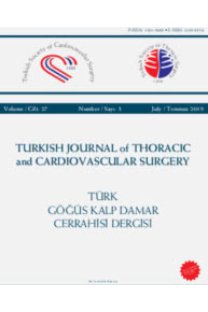Effects of robot- and video-assisted thoracoscopic lobectomy experiences on the learning curve of lobectomy
Robot ve video yardımlı torakoskopik lobektomi deneyimlerinin lobektominin öğrenme eğrisi üzerine etkileri
___
- 1. Agzarian J, Fahim C, Shargall Y, Yasufuku K, Waddell TK, Hanna WC. The use of robotic-assisted thoracic surgery for lung resection: A comprehensive systematic review. Semin Thorac Cardiovasc Surg 2016;28:182-92.
- 2. Wei B, Eldaif SM, Cerfolio RJ. Robotic lung resection for non-small cell lung cancer. Surg Oncol Clin N Am 2016;25:515-31.
- 3. Liang H, Liang W, Zhao L, Chen D, Zhang J, Zhang Y, et al. Robotic versus video-assisted lobectomy/segmentectomy for lung cancer: A meta-analysis. Ann Surg 2018;268:254-9.
- 4. Kanzaki M. Current status of robot-assisted thoracoscopic surgery for lung cancer. Surg Today 2019;49:795-802.
- 5. Louie BE, Wilson JL, Kim S, Cerfolio RJ, Park BJ, Farivar AS, et al. Comparison of video-assisted thoracoscopic surgery and robotic approaches for clinical stage I and stage II non-small cell lung cancer using the society of thoracic surgeons database. Ann Thorac Surg 2016;102:917-24.
- 6. Cerfolio RJ, Bryant AS, Skylizard L, Minnich DJ. Initial consecutive experience of completely portal robotic pulmonary resection with 4 arms. J Thorac Cardiovasc Surg 2011;142:740-6.
- 7. Arnold BN, Thomas DC, Bhatnagar V, Blasberg JD, Wang Z, Boffa DJ, et al. Defining the learning curve in robot-assisted thoracoscopic lobectomy. Surgery 2019;165:450-4.
- 8. Özyurtkan MO, Kaba E, Toker A. What happens while learning robotic lobectomy for lung cancer? J Vis Surg 2017;3:27.
- 9. Travis WD, Asamura H, Bankier AA, Beasley MB, Detterbeck F, Flieder DB, et al. The IASLC Lung Cancer Staging Project: Proposals for Coding T Categories for Subsolid Nodules and Assessment of Tumor Size in Part- Solid Tumors in the Forthcoming Eighth Edition of the TNM Classification of Lung Cancer. J Thorac Oncol 2016;11:1204-23.
- 10. Travis WD, Brambilla E, Nicholson AG, Yatabe Y, Austin JHM, Beasley MB, et al. The 2015 World Health Organization classification of lung tumors: Impact of genetic, clinical and radiologic advances since the 2004 classification. J Thorac Oncol 2015;10:1243-60.
- 11. Kent M, Wang T, Whyte R, Curran T, Flores R, Gangadharan S. Open, video-assisted thoracic surgery, and robotic lobectomy: Review of a national database. Ann Thorac Surg 2014;97:236-42.
- 12. Dylewski MR, Ohaeto AC, Pereira JF. Pulmonary resection using a total endoscopic robotic video-assisted approach. Semin Thorac Cardiovasc Surg 2011;23:36-42.
- 13. Park BJ, Flores RM, Rusch VW. Robotic assistance for video-assisted thoracic surgical lobectomy: Technique and initial results. J Thorac Cardiovasc Surg 2006;131:54-9.
- 14. Gharagozloo F, Margolis M, Tempesta B, Strother E, Najam F. Robot-assisted lobectomy for early-stage lung cancer: Report of 100 consecutive cases. Ann Thorac Surg 2009;88:380-4.
- 15. Cao C, Cerfolio RJ, Louie BE, Melfi F, Veronesi G, Razzak R, et al. Incidence, management, and outcomes of intraoperative catastrophes during robotic pulmonary resection. Ann Thorac Surg 2019;108:1498-504.
- 16. Louie BE, Farivar AS, Aye RW, Vallières E. Early experience with robotic lung resection results in similar operative outcomes and morbidity when compared with matched video-assisted thoracoscopic surgery cases. Ann Thorac Surg 2012;93:1598-604.
- 17. Meyer M, Gharagozloo F, Tempesta B, Margolis M, Strother E, Christenson D. The learning curve of robotic lobectomy. Int J Med Robot 2012;8:448-52.
- 18. Baldonado JJAR, Amaral M, Garrett J, Moodie C, Robinson L, Keenan R, et al. Credentialing for robotic lobectomy: What is the learning curve? A retrospective analysis of 272 consecutive cases by a single surgeon. J Robot Surg 2019;13:663-9.
- ISSN: 1301-5680
- Yayın Aralığı: Yılda 4 Sayı
- Başlangıç: 1991
- Yayıncı: Bayçınar Tıbbi Yayıncılık
Surgical treatment in malignant pleural effusion
Transözofageal ekokardiyografide beklenmeyen bir görüntü: Aortik kuspiste hiperekojen bir halka
Ekrem GÜLER, Ali Kemal KALKAN, Gamze BABÜR GÜLER, Kadriye MEMİÇ SANCAR, Tuğba AKTEMUR
Ko DAISIK, Choi SANGTAE, Lee WONSUK, Kang JINMO, Kim DOOJIN
Taylan Özgür SEZER, Muhtar Sinan ERSİN, Özgür FIRAT, Volkan SAYUR, Erkan GÜLER, Hakan POSACIOĞLU
Aynı heyecanla gelişmeye devam
Göğüs cerrahisinde farklı bir yaklaşım: Giyotin lobektomi
Hüseyin YILDIRAN, Güven Sadi SUNAM
Levent CANSEVER, Celal Buğra SEZEN, Onur Volkan YARAN, Salih DUMAN, Yunus SEYREK, Merve HATİPOĞLU, Kadriye ÖNEŞ, Mehmet Ali BEDİRHAN
An unexpected image on transesophageal echocardiography: A hyperechogenic ring on the aortic cusp
Kadriye MEMİÇ SANCAR, Tuğba AKTEMUR, Ali Kemal KALKAN, Gamze Babur GÜLER, Ekrem GÜLER
Gülçin YEĞEN, Esra KAYTAN SAĞLAM, Sezai VATANSEVER, Murat KARA, Şule Karaman, Erkan KABA, Yeşim ERALP, Berker ÖZKAN, Alper TOKER, Ahmer KIZIR, Naziye AK, Ferhat FERHATOĞLU, Esra AYDIN, Adnan AYDINER, Melike ÜLKER, Nergiz DAĞOĞLU, Soley BAYRAKTAR, Rian DİŞÇİ
